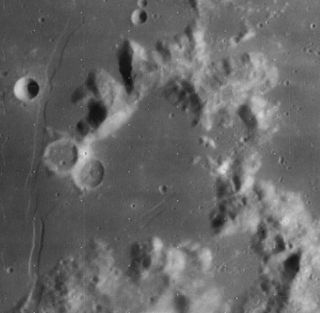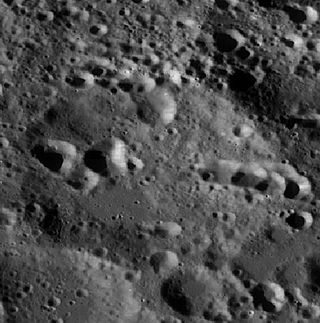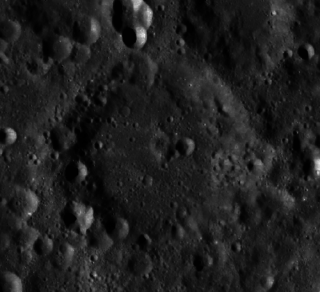
Posidonius is a lunar impact crater that is located on the north-eastern edge of Mare Serenitatis, to the south of Lacus Somniorum. It was named after ancient Greek philosopher and geographer Posidonius of Apamea. The crater Chacornac is attached to the southeast rim, and to the north is Daniell.

Abenezra is a lunar impact crater located in the rugged highlands in the south-central section of the Moon. Abenezra is named after the Sephardic Jewish sage, poet, biblical commentator, astronomer, and astrologer Abraham ibn Ezra. It is attached along the southeast rim to the crater Azophi. To the northeast lies the crater Geber, and further to the southeast is the larger Sacrobosco.

Bohr is a lunar impact crater that is located near the western lunar limb, in the area that is affected by librations. It is attached to the southwestern rim of the larger, eroded Vasco da Gama formation, and to the southeast of the crater Einstein. The crater was observed for the first time in 1963, by Arthus and Ewen Whitaker in the book Rectified Lunar Atlas.

Chamberlin is a lunar impact crater that is located on the far side of the Moon, just past the southeastern limb. It lies to the southeast of the crater Jeans, and Moulton is attached to the southeastern rim of Chamberlin. This crater is located in a part of the lunar surface that has undergone resurfacing of crater interiors, producing dark-hued crater floors.

Barringer is a lunar impact crater that is located on the southern hemisphere on the Far side of the Moon, named after geologist Daniel Barringer. It is attached to the north-northeastern rim of the walled basin named Apollo, and lies to the southeast of Plummer. South of Barringer, on the floor of the Apollo basin, is the crater Scobee.

Gaudibert is a lunar impact crater that lies along the northeast edge of Mare Nectaris in the eastern part of the Moon's near side. Just to the east is the Montes Pyrenaeus mountain chain, and to the northeast beyond the mountains is the crater Gutenberg. Northwest of Gaudibert is the crater pair Isidorus and Capella.

Hall is a lunar impact crater in the southeast part of the Lacus Somniorum, a lunar mare in the northeast part of the Moon. It was named after American astronomer Asaph Hall. This feature can be found to the east of the prominent walled plain Posidonius. Just to the south, and nearly attached to the southern rim of Hall is the smaller crater G. Bond.

Delaunay is a lunar impact crater. It was named after French astronomer Charles-Eugène Delaunay. The craters La Caille to the southwest and Faye to the northeast border on the outer rim of Delaunay. Further to the northwest is the prominent Arzachel.

Mason is the remains of a lunar impact crater that lies in the northeastern part of the Moon. It is nearly attached to the eastern rim of the flooded crater Plana, and southeast of Bürg. Along the northern rim of Mason is the southern edge of the Lacus Mortis, a small lunar mare. To the south is the larger Lacus Somniorum.

Chandler is a lunar impact crater in the northern hemisphere, on the Moon's far side. It lies to the southeast of the large walled plain D'Alembert, and southeast of the slightly smaller Chernyshev crater.

Comrie is a lunar impact crater. It is located on the rugged far side of the Moon relative to the Earth, beyond the western limb. Nearby craters of note include Ohm to the south-southwest, Shternberg to the southwest, and Parenago to the northeast.
Piazzi is an impact crater that is located near the southwestern limb of the Moon, and is attached to the southeastern rim of the walled plain Lagrange. About three crater diameters to the south is the crater Inghirami. Piazzi is seen at an oblique angle from the Earth, and it appears oblong due to foreshortening.

Lagalla is the remnant of a lunar impact crater. Wilhelm partly overlies the northeastern rim, and Montanari is attached to the southeast. The remainder of the rim is heavily eroded, with small craters overlaying sections along most of the sides. The rim is nearly nonexistent to the south, and the most intact portion is along the northwest. Lagalla F, an irregular satellite crater, is attached to the western rim. The interior floor is uneven and relatively featureless.

Chappe is a lunar impact crater that lies along the southwestern limb of the Moon. It is nearly attached to the northern limb of the walled plain Hausen, and an equal distance from the crater Pilâtre. To the north-northwest is Blanchard.

Ibn Firnas is a lunar impact crater on the far side of the Moon. In 1976 it was named after Abbas Ibn Firnas, a polymath from Andalucia who, in the 9th century, devised a chain of rings that could be used to simulate the motions of the planets and stars.

Dante is a lunar impact crater that is located on the far side of the Moon. It lies in the northern hemisphere exactly opposite the prime meridian facing the Earth. The nearest craters of note are Larmor to the north and Morse to the southeast. To the southwest is the oddly shaped Buys-Ballot.

Delporte is a lunar impact crater on the far side of the Moon. It overlies part of the northwestern rim of the huge walled plain Fermi, and the crater Litke is nearly attached to the southeastern rim. The crater is named after Eugène Joseph Delporte.

Fesenkov is a lunar impact crater on the far side of the Moon. It is located to the east-southeast of the prominent crater Tsiolkovskiy, and less than a crater diameter to the north of Stark.

Florensky is a lunar impact crater that is attached to the northeastern rim of the larger crater Vernadskiy. It is located on the far side of the Moon and cannot be directly seen from the Earth. The rim of this crater has been heavily eroded and it forms an irregular ring about the uneven interior. This crater was previously identified as Vernadskiy B before being assigned a name by the IAU in 1985.

Vernadskiy is a lunar impact crater on the far side of the Moon, behind the visible eastern limb. It lies to the west-northwest of the smaller crater Siedentopf. To the south is Gavrilov, and much farther to the west is Meggers.























